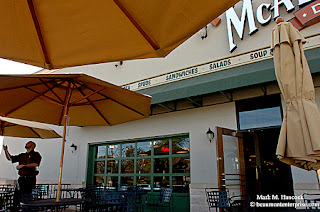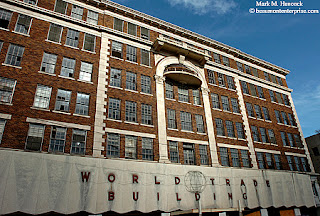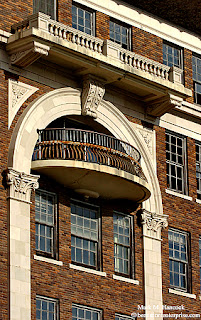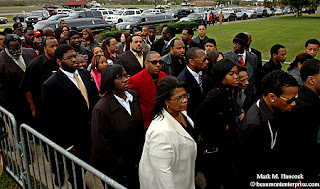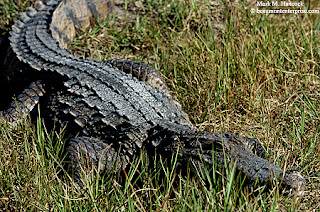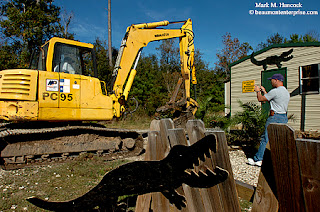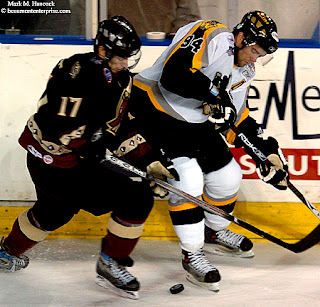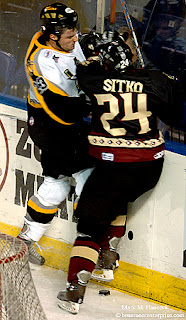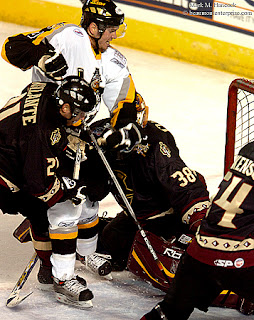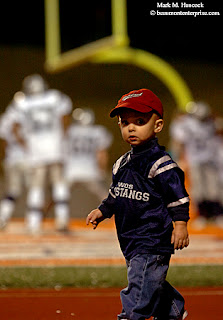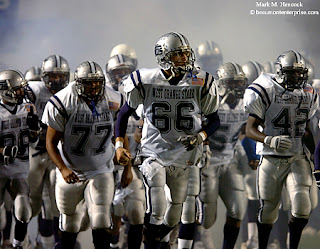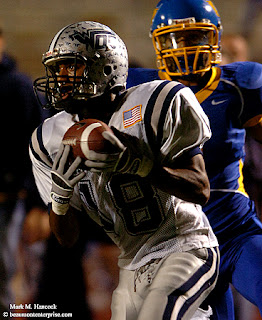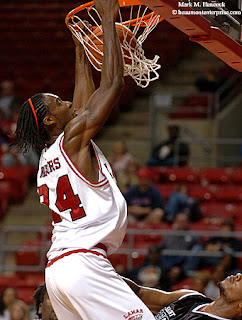Please
see the slideshow with examples (hit "back" on your browser to return to this post).
Many folks install decorative lights for different holidays from September through February. The most common holidays are Christmas, Yule, Hanukkah, Halloween/Samhain, Diwali, Kwanzaa and - on this coast -
Mardi Gras. Lights are attached to everything from homes and boats to people and floats.
Due to the work and cost invested into these sometimes elaborate decorations, PJs need to know how to photograph groups of light-emitting devices.
Although most PJs make this look easy, holiday lights are difficult to capture correctly. Consequently, this is a very info-heavy post. More casual shooters should probably read
Quick tips to shoot holiday lights instead.
First major hurdleWe know more light equals better exposures. Two 100-watt light bulbs produce twice as much light as one. Each additional light increases the amount of light falling on a subject.
Forget this rule while shooting lights as the primary subject.
When lights are the primary subject, each equally-powered and filtered light is about the same. This is because we meter the light source, not where the light is falling.
Distance dropoffIf a light is 100 feet away, it's about the same as lights 10 inches away from the camera (depends on moisture and pollution). Both lights are emitting the same amount of light. It's still subject to the inverse square law of light, but the source is constant and more intense than the light falloff.
The distance from the camera does play a role in digital dropoff. Film records each tiny light photon as it affects the silver halide to the point of reciprocity failure. Digital cameras record light on a sensor. As lights become more distant or camera angles become wider, their relative size becomes smaller. Eventually, they become too small for the digital sensor to record all of them. This creates a light loss which must be considered by digital photographers.
The opposite is also true. Because we're directly photographing lights rather than where the light falls, the largest lights spill onto nearby sensors.
Both effects happen with film, but aren't as pronounced.
Use a tripodEliminating
camera shake is
vital. Use a sturdy tripod. Most PJs also use electronic shutter release cables (called "plungers" by film shooters).
Because we're shooting a scene filled with highlights, any camera motion is amplified. This is compounded by slow shutter speeds. There is no way to hand-hold a camera absolutely still for six seconds.
It's not too hardAlthough the explanation may sound difficult, digital camera technology removed many of the problems of yesteryear. I could explain the nightmare this was in film days, but I'll spare y'all.
Now, simple color balance is one adjustment. Bracketing exposures is another automatic option. Chimping (looking at the preview screen) is probably the greatest advancement when it comes to accurately capturing holiday lights.
Meter failuresIt's important to remember a camera's (
reflective light) meter really doesn't know the difference between holiday lights and grains of sand. Even sophisticated automatic meters can be easily fooled by holiday lights.
A camera meter tries to find the average amount of light in a scene. It measures the amount of light areas (whites) with the amount of dark areas (blacks) and tries to find an average (gray).
Middle gray works for most daylight photography, but it's the worst option for holiday lights because both the highlights and shadows are ignored to find something in-between (the wrong exposure for both).
Pro shooters need to use manual controls for absolute exposures. Amateurs with advanced cameras may want to bracket exposures to get some usable shots. Point-and-shooters may end up needing to cover flashes and even sensors with black electrical tape to trick the camera into doing what's needed.
Have patienceIt takes a lot of patience to make beautiful images. It gets exponentially more difficult when trying to photograph holiday lights.
It takes a lot of time to compose images – particularly with a tripod. Exposures can often last several seconds. Getting the correct exposure takes additional time. It’s worth the work, but be patient.
At this point, it's probably best to separate shooters by ability. Select the most appropriate option to avoid confusion or boredom.
Casual photographerAdvanced amateurPro PJCasual shootersRecent camera advances removed most of the problems pro shooters had in the past. These technologies are incorporated into most amateur and pro-sumer cameras. So, let's do this the easy way before we get to exact exposures.
Disposable camerasPurchase a one-time-use film camera (disposable camera) loaded with 800 ISO film (most are). Depending on the brand and its actual settings, it should get roughly acceptable results.
The base exposure for most holiday lights is f/2.8 at 1/60th second on 800 ISO. If this means nothing to you, don't worry. Many disposable cameras can make this calculation (or something close to it) automatically.
The most important issue is to purchase a camera without a flash. If the only camera available comes with a flash, don't turn it on.
While several images aren't going to be properly recorded, a photo lab can often recover a "near miss" exposure. The most important factors are to be as steady as possible,
squeeze the shutter release and entirely fill the frame.
Point-and-shoot camerasExpect failures with point-and-shoot (P&S) cameras. They aren't designed to handle complex lighting situations. Experience with the camera (and many bad photos) is often the key to success.
The primary task with a P&S camera is to find the perfect balance of enough lights to trick the camera's meter. If the frame is filled with too much light, the meter underexposes and images look dark (or muddy as prints). If there aren't enough lights, the camera overexposes and everything washes out (there are no solid blacks).
Again, digital P&S cameras with a preview screen are best. Move around and keep shooting. Delete the bad frames later. Film P&S cameras may require several attempts (and some expense) to get a good shot.
P&S quick fixA quick fix is to emulate a disposable camera (see above). To do this, set the camera on 800 ISO and put electrical tape (black tape) over the flash. Some P&S cameras may also need the light sensor to be covered as well.
Advanced AmateursAdjustable SLR camerasMost single-lens-reflex (SLR) cameras have manual settings. For the most accurate manual settings and creative results, read the
pro advice below. Otherwise, this advice can quickly get some shots for the family photo album.
Use a tripod. Set the camera for tungsten light (the icon looks like a light bulb). Turn off the automatic flash. Set the film speed to 200 ISO. Set the camera to program or aperture priority (f/22 preferred).
Fill the frame with the composition. Focus the lens. Shoot. Now, set the exposure compensation to +1 and shoot. Just to be safe, bracket the same shot with a +2 setting and shoot. One of those three shots should do it.
If the camera has a preview screen, take a look (called "chimping"). If one of those three images looks perfect, note the exposure (since the camera is on a tripod, it shouldn't change much depending on the number of blinking lights). This should be the exposure for most of the scene (expect about f/5.6 at 1/8th for 200 ISO).
As new compositions are attempted, try to adjust the exposure compensation until the exposure is the same as the first image you liked (it might take +/- 5 stops to do it). It should be correct for the rest of the scene. If not, simply bracket the new composition until it looks OK.
Professional issuesHow to get the right meter readingUsing a hand-held reflective meter, slide the dome over the sensor. Choose the lowest-power clear twinkle light (the smallest one) and get a reading about an inch away from the light (expect about f/5.6 at 1/8th for 200 ISO).
Two stops over this reading (because we're shooting a "white" light) is the accurate exposure for a single lighting style scene. The +2 adjustment works fine on a single Christmas tree with identical lights.
When the scene is more complex, we must consider every type of light within the scene. I can imagine the OCD folks needing a paper bag about now. Relax. Instead of freaking over every little light, we must accept there's no way capture every scene. We need to let some lights blow out and some lights go black.
So, we'll only consider the extreme ranges of the scene. If we can keep both edges within a
dynamic range (five stops), there's no problem. If it creeps over both ends, we'll need to make some choices.
Calculate the best optionWe've established our base exposure. It should be around f/5.6 at 1/8th for 200 ISO. We added two stops, and now we're at f/5.6 at 1/2 second for 200 ISO. This is our corrected base exposure.
As other lights are considered, the corrected base exposure should only go down (less exposure) if we must move the range.
Next, identify and meter the brightest light in the scene. If the brightest light is within two stops, close down two stops and all is fine. If it's more than five stops, either consider excluding the light or controlling its duration (see below).
Light sourceThere are four basic decorative lighting schemes. These are: direct source light, reflected light, diffused light and mixed light.
This is the first issue to resolve before shooting because it determines the success of the shoot. Each light source requires a different approach. They can get especially tricky when combined.
Direct sourceMost holiday lights are direct source. The lights themselves are the decoration. Because the light itself is the subject, it's common for automatic cameras to underexpose these images for tight shots and overexpose for loose shots.
Reflected lightYard decorations and some trees are lit by an external light focused on the primary object. The most pleasing and visually challenging of these use an impressive array of (often colored or filtered) lights.
Because these items are typically spotlighted in a dark environment, it's common for automatic cameras to overexpose these images.
Diffused lightPlastic and inflatable nylon yard decorations typically contain internal lights. These lights are diffused as they pass through the object.
Often, the design of the decoration itself dictates photographic success. If powerful lights are located in the base and the light must somehow make a 90-degree turn to light a portion of the decoration, don't expect good results.
To be safe, take several meter readings from different parts of the decoration. Hopefully, the designer understood light and used more opaque materials closest to the light source(s).
If the meter readings fall within two stops of the base exposure, there's no problem. Otherwise, consider isolating, excluding or limiting the light duration of the decoration.
Mixed lightParade floats often employ a mix of lights. There are tiny direct lights as well as spotlights on float elements, which may have internal lights, and the entire float is further affected by street lamps and the headlights of other vehicles. If these are shot near sunset, twilight works into the background as well.
Many PJs also throw some fill flash into the mix to stop motion of the moving parade floats. The PJ must have a solid grip on all light qualities to get these shots.
Light levelsAs we determined, light sources and angles also determine how we must make the camera react for the amount of light we need to capture.
Next, we must determine how much light we want to capture. While this may sound obvious, it isn't. Unlike most
EV calculations, there are more wrong answers than correct answers with a large number of lights. Unfortunately, we're expected to find the single best answer of all the options.
Often this involves a balancing act between different sources, but it can also involve the intensity of different lights. It can be further complicated by the color of those lights due to the filtration process.
For brevity, the base exposure for most holiday lights is f/5.6 at 1/4th second on 200 ISO. This is also f/22 at four seconds on 200 ISO (six seconds is preferred due to reciprocity failure). This is the same as f/2.8 at 1/60th second on 800 ISO. Flash exposures should be manually factored to achieve desired results.
Limit light output optionsThe first issue is light output. It's critical to decide which light sources (or reflections) a PJ wants to capture in one image. These are purely subjective and aesthetic decisions. The PJ must make these choices to acquire the right image for this choice.
In mixed light, this may mean cropping out the brightest lights or letting the weakest lights fall into darkness. Sometimes it means adding artificial light (flash) or timing the shutter release for different strands of lights.
It might even involve partially blocking more intense lights during part of the exposure to get the exact cumulative amount of light.
If a photographer owns the property, it's best to set up reflective lights at the proper distance to provide even light. Otherwise, unplugging or blocking a floodlight with a camera bag for a few seconds during the exposure normally does the trick. The duration can be manually calculated.
Light filtrationIf all the lights in a scene are the same style, there's probably only a difference in luminescence caused by light color and age. While the bulb age may only cause one stop of variance, bulb color could cause four or more stops of light loss and create some significant problems.
The human eye sees all the lights as about the same intensity. The camera doesn't. Heavily dyed or filtered lights fall off the bottom of the dynamic range while unfiltered lights go past the top.
Because there's many companies make cheap holiday lights, there's no control on light quality or filtration. One company may use a heavy coat of paint to filter lights. Other companies may use a different formula or less dye.
Expect different brands of lights in one scene. If a PJ is lucky, the scene only contains various shades of one or several filtered colors. However, most scenes also contain unfiltered (clear) lights, which dominate the scene.
Even trees or other yard decorations with spotlights may have colored floodlights of different intensities. Include those with exposure levels closest to the main lights being captured. Avoid the brightest of these.
The most diabolical device is the color wheel. This cruel device rotates a filtered disk between a flood light and the subject being lit. It often moves through some combination of red, green, blue and yellow. Each color has a different filtration and exposure. Shots must be timed carefully to capture the correct colors and light intensity (particularly if other lights are also on blinking timers).
TimingMost PJs think about timing when we're shooting at 1/8000th of a second. After nailing fast action, a six-second exposure should be easy, but sometimes it's not.
Blinking lightsMost blinking lights are set on a timer (or timed fuse). They're on for a while, then off, then on, etc. At some point, all lights are on. It might require waiting six hours, but everything is likely to eventually sync.
The simplest way to handle this is to observe the light patterns and figure out when they will all sync. One shot, and it's done. Guess wrong, and do it all over again. It's only time.
The easier way to deal with this issue is to have one extremely long exposure to capture the entire cycle of lights. If all lights turn on and off for about the same amount of time, this is the best solution. It may require a neutral density filter (or four), but it's a surefire way to get the total effect of the lights.
If one strand of lights remains lit while the others blink, we're back to the first plan (waiting).
Choreographed light displaysWhile these displays are cool as heck, they're not so cool or easy to capture with a camera. The problem is they're choreographed to music. Not many songs use all the notes in equal portions. Therefore, some lights are going to be on longer than others.
To get the entire show in one shot is going to be a challenge. First, study the light pattern. If it's the same song over and over, it'll be much easier than a four-hour program. Even if it's the latter, there should still be enough repetition of pattern to make a successful image.
Because the lights are turned on unequally, the exposure must also be unequal. This is the root of the visual problem. To get the shot, we need a multiple exposure camera or some light-blocking barrier (mat board or black velvet cloth).
Multiple exposure cameras are best because we simply shoot fast, keep track of which sets of lights have been shot and wait for the unused ones. Once everything is shot, advance the frame and do the same two (or 10) more times to ensure one of the frames didn't have a boo-boo.
The shot is still possible without a multi-exposure camera. Expect to burn a lot more frames and only hope for something
near correct.
For simplicity, let's go with a standard six-second exposure. This means each light in the scene must be exposed to the film or CCD for a total of six seconds. Again, this could be a timing situation like the blinking lights above, but most often it's not.
To accomplish this shot, we'll use our light-blocking barrier and set the camera on bulb or 30 seconds manually. Next, we remove the barrier during the least often seen lights and immediately cover the lens when those lights turn off.
The folks who set the cameras on bulb can be more selective and have a higher chance of an accurate cumulative exposure. If all goes well, we should collect six seconds of all different sections of lights.
I said it wasn't easy.
TwilightAs
Marie commented in the
Quick tips post, light displays with twilight make magical images. As she stated, the sky has more color and more architectural detail is captured.
Part of the magic is how little time is available and how much skill is required to accomplish these images.
She pointed out the blue qualities of twilight. This is amplified when we color correct to tungsten light. Tungsten is primarily red with yellow. The complimentary color for red is cyan and the complimentary color for yellow is blue. When we try to make tungsten light about right, we shift all other light strongly into the blue range.
There's another way to correct with the red curve, but available light will shift toward green (yuck - unless it's Halloween). Consequently, a red sunset isn't going to be a reality unless neon-red house decorations are appropriate.
The entire trick to incorporating available light is arriving early. Break out the tripod; try a few angles and lenses until the best composition is found. Then wait.
We're waiting for available light in the background of our scene to be equal to or less than the lights we wish to photograph. This is where skill applies.
Because there is no universal "twilight" setting, we'll need to figure out the correct exposures on the fly (it changes for each exposure). There's no way to guess the correct exposure for every location and atmospheric condition around the world. We could let the camera do its thing and hope it comes out right, or we could help the process along.
My best advice is to walk the exposures down. This means light balances earliest with wider apertures (f/4) and last with tight apertures (f/22). Going back to our base exposure example, this means the first appropriate f/4 photo should be when available light hits 1/8th second on 200 ISO (or 1/16th on 400 ISO).
More color saturation occurs at a -2 ambient light (excluding holiday lights). This post is already too long to explain reciprocity failure and other factors involved with balancing available light and artificial light. If PJs understand what's going on, cool. If not, bracket like heck until twilight turns to night.
As stated, skill and experience are important when working with available light.
Color balanceWe're talking about colored lights, so color balance is somewhat subjective. We'd like filtered lights to appear near the same color we see with our eyes. To accomplish this, we need to determine the kind of light we're photographing.
Once we establish the actual light source, color correction becomes easier. Although there's everything from LED (light emitting diode) to mercury vapor lights in a scene, we need to identify and correct for the predominant type of light while shooting. We can adjust for the other lights when toning.
We've already covered how to
balance the light, so this is a quick reminder.
TungstenTungsten is the most common holiday light. It's inexpensive and widely available. Most present a pleasing warm tone (orange) in the 2500K or slightly lower range.
Film shooters need to use an 80A tungsten color-correction filter and compensate for light lost (about two stops) or use T-type (tungsten-balanced) film. Digital shooters need to use the tungsten setting, try to white balance or custom correct around 2500K.
LEDLED (light emitting diode) rock for several reasons. First, they're color balanced to 5500K. Set the camera for daylight, and we're cool.
These lights also use far less energy, so they're good for the environment and the checkbook. They also don't burn out or break like filament-based lights. So, they could last many years without replacement.
Lastly - but most importantly - they're safe. LED lights don't waste energy to create heat as halogen and tungsten lights do. Consequently, they're far less likely to ignite trees,
models or other decorations.
While PJs cover fires, we'd rather not. We cover the fire to show tax dollars at work (the firefighters), but we also want to get help from our readers for the newly-displaced family or business.
PJs would much rather spend the holidays with their families than covering a tragedy. LED lights can still have wiring issues, but they're much safer than other holiday lights.
The main lighting concern with LEDs is the minimum exposure. Because these lights are regulated by
electrical cycle (60 cycles per second), exposures should be 1/60th or slower (1/30th is better) to ensure a correct exposure. Needless to say, a tripod is required.
Get good at working with LED light (as a source and subject) because almost all lights are heading in this direction due to the latest energy bill. Many light-bank units are already moving in this direction.
Candle light
In Texas, several homes have luminarias. These are candles or other lights contained within paper or plastic sacks with decorative designs.
While the sack itself is brown and may contain colored plastic or tissue paper to produce stained-glass effects, the light inside is what matters to PJs. Take a look in one of the sacks and be certain of the light source. If it's tungsten light, balance for tungsten.
If it's a candle, it's 1500K. Either dial in the K temp or use the tungsten setting and color correct while toning.
Film shooters need to use an 80A tungsten color-correction filter and compensate for lost light (about two stops) or use T-type (tungsten-balanced) film. Images need additional post-production correction.
Flash
Color balance the flash with CC gels to the predominant light source. LED requires no additional balancing.
Composition
As always, the name of the game is fill the frame. Look at the scene and select elements to include within the frame. Arrange the composition to highlight those elements and exclude unwanted elements.
The balancing act with lighted scene compositions is more delicate than most other compositions because the majority of the scene is literally nothing. It's empty black space surrounding a highlight.
Too much space becomes boring. Too little makes the scene look cluttered.
Look at the lights from various angles with different lenses to determine how to best see the scene. Although not always obvious or deliberate, holiday lights often have hidden connect-the-dot patterns within the scene. Look for these as well as overall compositions.
Dominant elements
In standard photographic compositions, we place a dominant element in an environment. When shooting fireworks or working with holiday lights, it becomes more important.
Everyone gets wowed by cool displays of lights. It's important to search the scene and find something to nail down the image. Without a dominant focal point or repetition of pattern, the image quickly falls apart.
Depth of field plays an important role in determining the plane of focus, but the composition still requires key elements. It's important to use compositional conventions to capture meaningful images. Traditional tools such as image skeletal structure, Golden Ratio, and balance are more important when so many conflicting elements are introduced.
Creative effects
Pros often introduce additional creative effects to make images shine.
Depth of field
Using the maximum aperture produces a natural streaking of light from point-source lights.
Selective focus when combined with a shallow depth-of-field and close focus creates a stunning effect with a sharp subject and soft circles of light in the background.
Fog effect
Fog refracts point-source lights and adds a nice "glow" to the light. In cold, dry climates, fog can be replicated by breathing on the camera lens immediately before shooting.
Zoom
Zooming during an exposure creates a Superman-type effect. However, don't zoom more than 1/3rd of the total exposure duration to keep the base image recognizable. Extra care must be taken to ensure focus during the zoom with double-action lenses (singly-controlled focus and zoom).
Double exposure
If a camera is equipped for double exposures, many creative options are available. A popular option is to make one out-of-focus exposure and sharply focus for the second exposure. This creates wide glows around the primary lights. Repetition of pattern can also be accomplished with double exposures.
Another option is to make multiple partial exposures to limit total input from selected (blinking) areas of the scene. However, make sure to reach the minimum cumulative exposure.
Using the multi-exposure speed method allows PJs to include different colored gels for wild effects. Food preparation cling wrap wound onto bent coat hangers can be "dodged" during some of the exposures to make unique images.
Experiment with all options.
Flash with blur
A popular professional technique is using flash with blur. This technique is most often used for portraits. Focus and rear-synch flash exposure are pre determined. A long exposure is selected and the camera is moved until the flash fires. A similar technique is to use a front-curtain flash synch and zoom. Both create unusual images when combined with holiday lights.
Only the "Old Timers" will understand this, but images can be reverse light painted. The process is similar to shaking an enlargement print around a dodge. Essentially, the camera is moved during a slow, rear sync flash exposure to increase virtual volume to existing lights while the primary subject is dark. When the flash fires, the frame is completed with some very cool light.
Catadioptric lens
Some photographers have special lenses, which produce unusual images. A rare catadioptric lens uses mirrors to increase focal length. It also creates fun donut shapes with out-of focus lights. Popular and inexpensive Lens Babies allow for focal plane adjustments and very interesting light patterns.
FX filters
Special effects filters, also called "trick" or "gimmick" filters, change light in various ways. The most popular are starlight filters, which refract and channel point-source light to create long projections from the light. Radiant and multi-parallel filters also work well with lights.
Lens flare
Lens flare occurs when light directly hits the lens. It's very likely to occur while making images of holiday lights. Most of the time, PJs try to avoid lens flare. However, we can occasionally use it to our advantage and amplify the amount or quality of specific lights.
Flare isn't hard to capture. Get close enough to any significant light source, let it directly hit the lens, and there you go. One incidence of flare occurs for each lens element the light strikes.
If flare is a desired goal, work it properly to ensure its effect is appropriate and deliberate. Otherwise, it looks like a mistake.
Enough for now,







